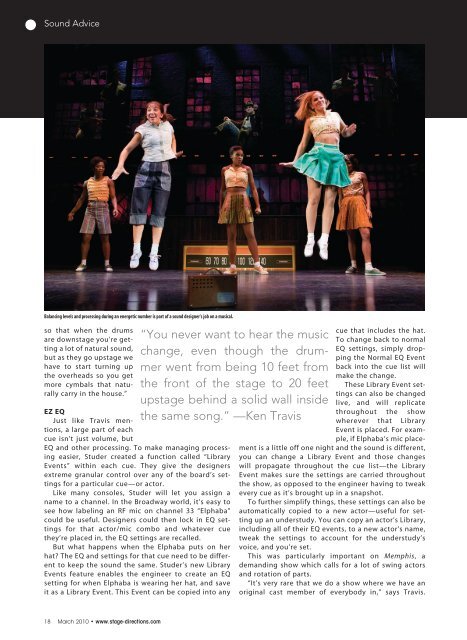Download a PDF - Stage Directions Magazine
Download a PDF - Stage Directions Magazine
Download a PDF - Stage Directions Magazine
You also want an ePaper? Increase the reach of your titles
YUMPU automatically turns print PDFs into web optimized ePapers that Google loves.
Sound Advice<br />
Balancing levels and processing during an energetic number is part of a sound designer’s job on a musical.<br />
so that when the drums<br />
are downstage you’re getting<br />
a lot of natural sound,<br />
but as they go upstage we<br />
have to start turning up<br />
the overheads so you get<br />
more cymbals that naturally<br />
carry in the house.”<br />
EZ EQ<br />
Just like Travis mentions,<br />
a large part of each<br />
cue isn’t just volume, but<br />
EQ and other processing. To make managing processing<br />
easier, Studer created a function called “Library<br />
Events” within each cue. They give the designers<br />
extreme granular control over any of the board’s settings<br />
for a particular cue—or actor.<br />
Like many consoles, Studer will let you assign a<br />
name to a channel. In the Broadway world, it’s easy to<br />
see how labeling an RF mic on channel 33 “Elphaba”<br />
could be useful. Designers could then lock in EQ settings<br />
for that actor/mic combo and whatever cue<br />
they’re placed in, the EQ settings are recalled.<br />
But what happens when the Elphaba puts on her<br />
hat? The EQ and settings for that cue need to be different<br />
to keep the sound the same. Studer’s new Library<br />
Events feature enables the engineer to create an EQ<br />
setting for when Elphaba is wearing her hat, and save<br />
it as a Library Event. This Event can be copied into any<br />
“You never want to hear the music<br />
change, even though the drummer<br />
went from being 10 feet from<br />
the front of the stage to 20 feet<br />
upstage behind a solid wall inside<br />
the same song.” —Ken Travis<br />
cue that includes the hat.<br />
To change back to normal<br />
EQ settings, simply dropping<br />
the Normal EQ Event<br />
back into the cue list will<br />
make the change.<br />
These Library Event settings<br />
can also be changed<br />
live, and will replicate<br />
throughout the show<br />
wherever that Library<br />
Event is placed. For example,<br />
if Elphaba’s mic placement<br />
is a little off one night and the sound is different,<br />
you can change a Library Event and those changes<br />
will propagate throughout the cue list—the Library<br />
Event makes sure the settings are carried throughout<br />
the show, as opposed to the engineer having to tweak<br />
every cue as it’s brought up in a snapshot.<br />
To further simplify things, these settings can also be<br />
automatically copied to a new actor—useful for setting<br />
up an understudy. You can copy an actor’s Library,<br />
including all of their EQ events, to a new actor’s name,<br />
tweak the settings to account for the understudy’s<br />
voice, and you’re set.<br />
This was particularly important on Memphis, a<br />
demanding show which calls for a lot of swing actors<br />
and rotation of parts.<br />
“It’s very rare that we do a show where we have an<br />
original cast member of everybody in,” says Travis.<br />
18 March 2010 • www.stage-directions.com

















